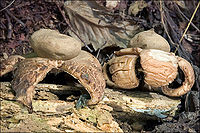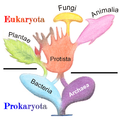Our website is made possible by displaying online advertisements to our visitors.
Please consider supporting us by disabling your ad blocker.
Portal:Fungi
The Fungi Portal
A fungus is any member of a large group of eukaryotic organisms that includes microorganisms such as yeasts and molds, as well as the more familiar mushrooms. The Fungi are classified as a kingdom that is separate from plants and animals. The discipline of biology devoted to the study of fungi is known as mycology or fungal biology, which is historically regarded as a branch of botany, even though genetic studies have shown that fungi are more closely related to animals than to plants. Fungi reproduce via spores and grow as hyphae, mycelia, and further specialized structures. Fungal spores are often produced on specialized structures or in fruiting bodies, such as the head of a mushroom. Abundant worldwide, most fungi are mostly invisible to the naked eye because of the small size of their structures, and their cryptic lifestyles in soil, on dead matter, and as symbionts of plants, animals, or other fungi. Fungi perform an essential role in the decomposition of organic matter and have fundamental roles in nutrient cycling and exchange. They have long been used as a direct source of food, such as mushrooms and truffles, as a leavening agent for bread, and in fermentation of various food products, such as wine, beer, and soy sauce.
Since the 1940s, fungi have been used for the production of antibiotics, and, more recently, various enzymes produced by fungi are used industrially and in detergents. Fungi are also used as biological agents to control weeds and pests. Many species produce bioactive compounds called mycotoxins, such as alkaloids and polyketides, that are toxic to animals including humans. The fruiting structures of a few species are consumed recreationally or in traditional ceremonies as a source of psychotropic compounds. Fungi can break down manufactured materials and buildings, and become significant pathogens of humans and other animals. Losses of crops due to fungal diseases or food spoilage can have a large impact on human food supplies and local economies. Despite their importance on human affairs, little is known of the true biodiversity of Kingdom Fungi, which has been estimated at around 1.5 million species, with about 5% of these having been formally classified.
| More about fungi... |
Selected article
Geastrum triplex is a common and widespread species found in the detritus and leaf litter of hardwood forests in many parts of the world, including Asia, Australasia, Europe, and both North and South America. Fruit bodies have been analyzed chemically to determine their lipid content, and various chemical derivatives of the fungal sterol ergosterol have been identified. The fungus has a history of use in the traditional medicines of native North America and China.
Selected species
Things to do
If you want to help Wikipedia to improve its coverage of fungi, here are some things you can do...
- Assess some fungi articles.
- Join Wikipedia:WikiProject Fungi or ask on the talk page.
- Join the lichen task force.
- Review, improve, expand or clean some of the newly created fungi-related articles.
- Expand some high priority fungus stubs.
- Expand or sort other fungi-related stubs.
- Add images to articles in the list of unillustrated fungi articles, or add more articles to the list.
- Write fungi-related articles from scratch. For ideas of needed articles, see the redlinks on-
- Review the fungi articles flagged as needing attention.
WikiProjects
WikiProjects related to fungi:
Selected picture

Did you know?
- ... that the mushroom Cystodermella cinnabarina can only be distinguished from similar fungi by performing chemical tests and microscopic analysis of spores, basidia and cystidia?
- ... that the bolete eater which attacks boletes is actually another type of fungus?
- ... that the mushroom species Russula albidula is commonly known as the "boring white Russula"?
- ... that infection by pistil smut induces the development of female sex organs in a male?
- ... that hairy black cups use toxic chemicals to kill living things?
General images -
Related portals
Topics
- Main topics lists: Outline of fungi and Outline of lichens
- Fungi: Bracket fungus, carnivorous fungus, coprophilous fungi, entomopathogenic fungus, evolution of fungi, lichen, mushroom, mycology (lichenology, mycotoxicology, paleomycology), mycorrhiza, pathogenic fungi, puffball, wood-decay fungus
- Fungal orders: Chytridiomycota, Blastocladiomycota, Neocallimastigomycota, Zygomycota, Glomeromycota. Dikarya: Ascomycota, Basidiomycota
- Fungi lists: Species: Agaricus species, Amanita species, Boletus species, Cortinarius species, Cyathus species, Hygrocybe species, Hygrophorus species, Inocybe species, Lactarius species, Mycosphaerella species, Panaeolus species, Psilocybe species, Russula species, Scleroderma species Other lists: Mycology journals, psilocybin mushrooms
- Uses: Edible mushroom, mushroom poisoning, psilocybin mushrooms, mushroom hunting, fungiculture, fermentation, baker's yeast, mycoremediation, lichenometry, mushroom dye
Categories
Previous Page Next Page









![Image 5Pennate diatom from an Arctic meltpond, infected with two chytrid-like [zoo-]sporangium fungal pathogens (in false-colour red). Scale bar = 10 μm. (from Marine fungi)](http://upload.wikimedia.org/wikipedia/commons/thumb/b/b5/Pennate_diatom_infected_with_two_chytrid-like_fungal_pathogens.png/120px-Pennate_diatom_infected_with_two_chytrid-like_fungal_pathogens.png)

























































